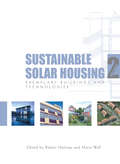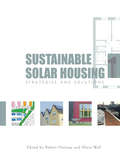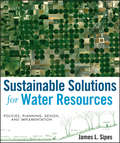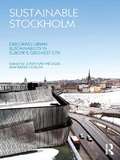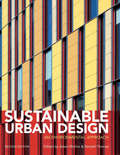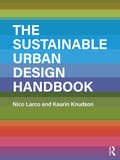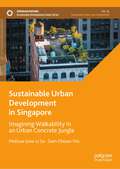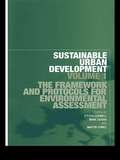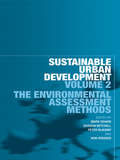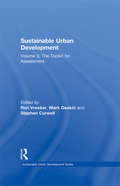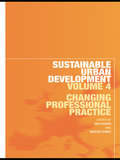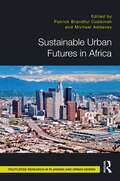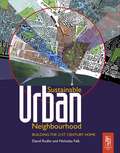- Table View
- List View
Sustainable Solar Housing: Volume 2 - Exemplary Buildings and Technologies
by Robert S. Hastings Maria WallThis far-reaching and authoritative two-volume set examines a range of potential solutions for low-energy building design, considering different strategies (energy conservation and renewable energy) and technologies (relating to the building envelope, ventilation, heat delivery, heat production, heat storage, electricity and control). Energy and life-cycle impacts are considered as crucial factors, including passive and active solar use, daylighting and high efficiency conventional heat production. Each volume assesses the potential of these options in a variety of contexts, covering different housing types (apartment, row and detached) in cold, temperate and mild climates. The impressive list of expert authors from 14 countries includes a mix of internationally respected academics and practitioners, working together within the framework of a five-year International Energy Agency (IEA) research project. Volume 1 presents strategies and solutions, offering the reader a solid basis for developing concepts, considering environmental and economic concerns for housing projects in a variety of contexts. Volume 2 offers a detailed analysis of exemplary buildings in different European countries and examines the various technologies employed to achieve their remarkable performance. Aided by clear, full colour illustrations, it offers invaluable insights into the application of these technologies.
Sustainable Solar Housing: Volume 1 - Strategies and Solutions
by Robert S. Hastings Maria WallThis far-reaching and authoritative two-volume set examines a range of potential solutions for low-energy building design, considering different strategies (energy conservation and renewable energy) and technologies (relating to the building envelope, ventilation, heat delivery, heat production, heat storage, electricity and control). Energy and life-cycle impacts are considered as crucial factors, including passive and active solar use, daylighting and high efficiency conventional heat production. Each volume assesses the potential of these options in a variety of contexts, covering different housing types (apartment, row and detached) in cold, temperate and mild climates. The impressive list of expert authors from 14 countries includes a mix of internationally respected academics and practitioners, working together within the framework of a five-year International Energy Agency (IEA) research project. Volume 1 presents strategies and solutions, offering the reader a solid basis for developing concepts, considering environmental and economic concerns for housing projects in a variety of contexts. Volume 2 offers a detailed analysis of exemplary buildings in different European countries and examines the various technologies employed to achieve their remarkable performance. Aided by clear, full colour illustrations, it offers invaluable insights into the application of these technologies.
Sustainable Solar Housing: Volume 2 - Exemplary Buildings and Technologies
by Robert Hastings Maria WallThis far-reaching and authoritative two-volume set examines a range of potential solutions for low-energy building design, considering different strategies (energy conservation and renewable energy) and technologies (relating to the building envelope, ventilation, heat delivery, heat production, heat storage, electricity and control). Energy and life-cycle impacts are considered as crucial factors, including passive and active solar use, daylighting and high efficiency conventional heat production. Each volume assesses the potential of these options in a variety of contexts, covering different housing types (apartment, row and detached) in cold, temperate and mild climates. The impressive list of expert authors from 14 countries includes a mix of internationally respected academics and practitioners, working together within the framework of a five-year International Energy Agency (IEA) research project. Volume 1 presents strategies and solutions, offering the reader a solid basis for developing concepts, considering environmental and economic concerns for housing projects in a variety of contexts. Volume 2 offers a detailed analysis of exemplary buildings in different European countries and examines the various technologies employed to achieve their remarkable performance. Aided by clear, full colour illustrations, it offers invaluable insights into the application of these technologies.
Sustainable Solar Housing: Volume 1 - Strategies and Solutions
by S. Robert Hastings Maria WallThis far-reaching and authoritative two-volume set examines a range of potential solutions for low-energy building design, considering different strategies (energy conservation and renewable energy) and technologies (relating to the building envelope, ventilation, heat delivery, heat production, heat storage, electricity and control). Energy and life-cycle impacts are considered as crucial factors, including passive and active solar use, daylighting and high efficiency conventional heat production. Each volume assesses the potential of these options in a variety of contexts, covering different housing types (apartment, row and detached) in cold, temperate and mild climates. The impressive list of expert authors from 14 countries includes a mix of internationally respected academics and practitioners, working together within the framework of a five-year International Energy Agency (IEA) research project. Volume 1 presents strategies and solutions, offering the reader a solid basis for developing concepts, considering environmental and economic concerns for housing projects in a variety of contexts. Volume 2 offers a detailed analysis of exemplary buildings in different European countries and examines the various technologies employed to achieve their remarkable performance. Aided by clear, full colour illustrations, it offers invaluable insights into the application of these technologies.
Sustainable Solutions for Water Resources: Policies, Planning, Design, and Implementation
by James L. SipesGet the single-source solutions guide to the sustainable management of water resources. Why is water the environmental issue? The answer is simple: without it, life on this planet could not exist. Yet, despite this fact, reckless consumption practices from a growing population are drying up the Earth's already limited water resources. Other factors, such as river and lake contamination, rising temperatures, and disproportionate geographic accessibility further contribute to the fresh water crisis. To confront this pressing concern, this enlightening guide, which covers over twenty case studies offering insights into real-world projects, uses a holistic, integrated approach to illustrate ways to preserve vital water supplies -- from green design remedies to encouraging greater personal responsibility. This book: Provides a basic overview of water resources, hydrology, current problems involving water resources, and the potential impact of global warming and climate change. Covers watershed planning, Best Management Practices, and potential design and planning solutions. Offers a concise overview of the issues affecting water use and management. Includes a full chapter dedicated to planning issues, and a full chapter covering site planning, design, and implementation. Sustainable Solutions for Water Resources takes a practical approach to head off a global water catastrophe by offering sensible measures that can be put in place immediately to promote a clean, plentiful flow of the Earth's most precious resource.
Sustainable Solutions for Water Resources: Policies, Planning, Design, and Implementation
by James L. SipesGet the single-source solutions guide to the sustainable management of water resources. Why is water the environmental issue? The answer is simple: without it, life on this planet could not exist. Yet, despite this fact, reckless consumption practices from a growing population are drying up the Earth's already limited water resources. Other factors, such as river and lake contamination, rising temperatures, and disproportionate geographic accessibility further contribute to the fresh water crisis. To confront this pressing concern, this enlightening guide, which covers over twenty case studies offering insights into real-world projects, uses a holistic, integrated approach to illustrate ways to preserve vital water supplies -- from green design remedies to encouraging greater personal responsibility. This book: Provides a basic overview of water resources, hydrology, current problems involving water resources, and the potential impact of global warming and climate change. Covers watershed planning, Best Management Practices, and potential design and planning solutions. Offers a concise overview of the issues affecting water use and management. Includes a full chapter dedicated to planning issues, and a full chapter covering site planning, design, and implementation. Sustainable Solutions for Water Resources takes a practical approach to head off a global water catastrophe by offering sensible measures that can be put in place immediately to promote a clean, plentiful flow of the Earth's most precious resource.
Sustainable Stockholm: Exploring Urban Sustainability in Europe’s Greenest City
by Jonathan Metzger Amy Rader OlssonSustainable Stockholm provides a historical overview of Stockholm’s environmental development, and also discusses a number of cross-disciplinary themes presenting the urban sustainability work behind Stockholm’s unique position, and importantly the question of how well Stockholm’s practices can be exported and transposed to other places and contexts. By using the case of Stockholm as the pivot of discussions, Sustainable Stockholm investigates the core issues of sustainable urban environmental development and planning, in all their entanglements. The book shows how intersecting fields such as urban planning and architecture, traffic planning, land-use regulation, building, waste management, regional development, water management, infrastructure engineering—together and in combination—have contributed to making Stockholm Europe’s "greenest" city.
Sustainable Stockholm: Exploring Urban Sustainability in Europe’s Greenest City
by Jonathan Metzger Amy Rader OlssonSustainable Stockholm provides a historical overview of Stockholm’s environmental development, and also discusses a number of cross-disciplinary themes presenting the urban sustainability work behind Stockholm’s unique position, and importantly the question of how well Stockholm’s practices can be exported and transposed to other places and contexts. By using the case of Stockholm as the pivot of discussions, Sustainable Stockholm investigates the core issues of sustainable urban environmental development and planning, in all their entanglements. The book shows how intersecting fields such as urban planning and architecture, traffic planning, land-use regulation, building, waste management, regional development, water management, infrastructure engineering—together and in combination—have contributed to making Stockholm Europe’s "greenest" city.
Sustainable Urban Design: An Environmental Approach
by Adam Ritchie Randall ThomasBy the end of the twenty-first century it is thought that three-quarters of the world’s population will be urban; our future is in cities. Making these cities healthy, vibrant and sustainable is an exceptional challenge which this book addresses. It sets out some of the basic principles of the design of our future cities and, through a series of carefully-selected case studies from leading designers’ experience, illustrates how these ideas can be put into practice. Building on the first edition's original format of design guidance and case studies, this new edition updates the ideas and techniques resulting from further research and practice by the contributors. This book emphasises the enormous progress made towards exciting new designs that integrate good design with resource efficiency.
Sustainable Urban Design: An Environmental Approach
by Adam Ritchie Randall ThomasBy the end of the twenty-first century it is thought that three-quarters of the world’s population will be urban; our future is in cities. Making these cities healthy, vibrant and sustainable is an exceptional challenge which this book addresses. It sets out some of the basic principles of the design of our future cities and, through a series of carefully-selected case studies from leading designers’ experience, illustrates how these ideas can be put into practice. Building on the first edition's original format of design guidance and case studies, this new edition updates the ideas and techniques resulting from further research and practice by the contributors. This book emphasises the enormous progress made towards exciting new designs that integrate good design with resource efficiency.
The Sustainable Urban Design Handbook
by Nico Larco Kaarin KnudsonThe Sustainable Urban Design Handbook gathers the best sustainability practices and latest research from the fields of architecture, landscape architecture, planning, development, ecology, and environmental engineering and presents them in a graphically rich and accessible format that can help guide urban design decisions in cities of all sizes.The book presents a comprehensive framework that organizes more than 50 elements of sustainable urban design under five main topics–Energy Use & Greenhouse Gas, Water, Ecology & Habitat, Energy Use & Production, and Equity & Health–and relative to four project scales: Region & City, District & Neighborhood, Block & Street, and Project & Parcel. Each element chapter includes a summary of importance and background, compares typical practices and recommended approaches, explains connections to other elements, and concludes with urban design guidelines that can be used to directly inform projects and decisions.Easy to use and reference, The Sustainable Urban Design Handbook provides both an in-depth introduction to topics across sustainable urban design and serves as an on-going reference for anyone involved in the creation of sustainable urban environments. This resource will be useful to design and planning professionals, community members, students, and elected officials in guiding decisions about our sustainable future.
The Sustainable Urban Design Handbook
by Nico Larco Kaarin KnudsonThe Sustainable Urban Design Handbook gathers the best sustainability practices and latest research from the fields of architecture, landscape architecture, planning, development, ecology, and environmental engineering and presents them in a graphically rich and accessible format that can help guide urban design decisions in cities of all sizes.The book presents a comprehensive framework that organizes more than 50 elements of sustainable urban design under five main topics–Energy Use & Greenhouse Gas, Water, Ecology & Habitat, Energy Use & Production, and Equity & Health–and relative to four project scales: Region & City, District & Neighborhood, Block & Street, and Project & Parcel. Each element chapter includes a summary of importance and background, compares typical practices and recommended approaches, explains connections to other elements, and concludes with urban design guidelines that can be used to directly inform projects and decisions.Easy to use and reference, The Sustainable Urban Design Handbook provides both an in-depth introduction to topics across sustainable urban design and serves as an on-going reference for anyone involved in the creation of sustainable urban environments. This resource will be useful to design and planning professionals, community members, students, and elected officials in guiding decisions about our sustainable future.
Sustainable Urban Development in Singapore: Imagining Walkability in an Urban Concrete Jungle (Sustainable Development Goals Series)
by Melissa Liow Li Sa Sam Choon-YinThis book offers theoretical and practical insights into land use, transport, and national policies in one of world’s well-known urban concrete jungle, none other than the Singapore city. The emphasis is situated on Singapore’s attempt to promote walking and cycling. Greater appreciation of walkability thrives on Singapore’s rich history, green city, people and the gastronomic kopitiam and hawker culture. The book offers a comprehensive coverage of walkability as a crucial component of urban design to reduce vehicular congestion with the associated carbon emissions, foster a healthy lifestyle and community participation and create jobs to help the economy. A high income per capita and an aging society, lessons drawn from Singapore’s experience will be useful to other societies. Scholars in sustainable tourism field, urban planners, government bodies, tourist boards, entrepreneurs, national parks board, residents, and inbound travellers will benefit from reading the book.
Sustainable Urban Development Volume 1: The Framework and Protocols for Environmental Assessment (Sustainable Urban Development Series)
by Stephen Curwell Mark Deakin Martin SymesBased on original research, this first volume of a set of groundbreaking new books sets out a framework for analyzing sustainable urban development and develops a set of protocols for evaluating the sustainability of urban development. Protocols included are for sustainable urban planning, urban property development, urban design, the construction, operation and use of buildings. Using these protocols, the book goes on to provide a directory of environmental assessment methods for evaluating the sustainability of urban development and also maps out how these assessment methods are being transformed to evaluate the environmental, economic and social sustainability of urban development. Web-based applications are increasingly being used to support this transformation and the contributors deftly cover this application and issues concerning the use of information and communication technologies for evaluating the sustainability of urban development are also dealt with. With its multidisciplinary approach, Sustainable Urban Development presents key new material for postgraduates and professionals across the built environment.
Sustainable Urban Development Volume 1: The Framework and Protocols for Environmental Assessment (Sustainable Urban Development Series #Vol. 1)
by Steven Curwell Mark Deakin Martin SymesBased on original research, this first volume of a set of groundbreaking new books sets out a framework for analyzing sustainable urban development and develops a set of protocols for evaluating the sustainability of urban development. Protocols included are for sustainable urban planning, urban property development, urban design, the construction, operation and use of buildings. Using these protocols, the book goes on to provide a directory of environmental assessment methods for evaluating the sustainability of urban development and also maps out how these assessment methods are being transformed to evaluate the environmental, economic and social sustainability of urban development. Web-based applications are increasingly being used to support this transformation and the contributors deftly cover this application and issues concerning the use of information and communication technologies for evaluating the sustainability of urban development are also dealt with. With its multidisciplinary approach, Sustainable Urban Development presents key new material for postgraduates and professionals across the built environment.
Sustainable Urban Development Volume 2: The Environmental Assessment Methods (Sustainable Urban Development Series)
by Mark Deakin Gordon Mitchell Peter Nijkamp Ron VreekerIn this book, the second of a three-volume series, leading authorities on the methodology of environmental assessment provide a unique insight into questions of critical importance to sustainable urban development. Using the framework and protocols set out in Volume 1, Volume 2 examines how well the environmental assessment methods evaluate the ecological integrity of urban development and equity of the resulting resource distribution. The examination focuses on: the instruments of environmental assessment approaches to environmental assessment based in systems-thinking methods for environmental, economic and social assessments their use in evaluating the sustainability of urban development. The Sustainable Urban Development Series contains the research and debate of the BEQUEST (Building, Environmental Quality Evaluation for Sustainability) network funded by the European Commission. Together the books provide a framework, set of protocols, environmental assessment methods and toolkit for policy makers, academics, professionals and advanced level students in urban planning and studies, as well as other areas of the built environment.
Sustainable Urban Development Volume 2: The Environmental Assessment Methods (Sustainable Urban Development Series #Vol. 2)
by Mark Deakin Gordon Mitchell Peter Nijkamp Ron VreekerIn this book, the second of a three-volume series, leading authorities on the methodology of environmental assessment provide a unique insight into questions of critical importance to sustainable urban development. Using the framework and protocols set out in Volume 1, Volume 2 examines how well the environmental assessment methods evaluate the ecological integrity of urban development and equity of the resulting resource distribution. The examination focuses on: the instruments of environmental assessment approaches to environmental assessment based in systems-thinking methods for environmental, economic and social assessments their use in evaluating the sustainability of urban development. The Sustainable Urban Development Series contains the research and debate of the BEQUEST (Building, Environmental Quality Evaluation for Sustainability) network funded by the European Commission. Together the books provide a framework, set of protocols, environmental assessment methods and toolkit for policy makers, academics, professionals and advanced level students in urban planning and studies, as well as other areas of the built environment.
Sustainable Urban Development Volume 3: The Toolkit for Assessment (Sustainable Urban Development Series)
by Ron Vreeker Mark Deakin Stephen CurwellThe third volume of the Sustainable Urban Development Series outlines the BEQUEST toolkit that helps link protocol with the assessment methods currently available for evaluating the sustainability of urban development. It details the decision support mechanisms developed for users of the system to guide them in selecting the appropriate assessment methods for a variety of evaluations.This book provides case studies drawn from locations across Europe, and also provides best practice examples demonstrating those protocols that planners, property developers and design and construction professionals have followed, and how they have selected the assessment methods they need to best evaluate the sustainability of cities, districts, neighbourhoods and buildings.
Sustainable Urban Development Volume 3: The Toolkit for Assessment (Sustainable Urban Development Series)
by Ron Vreeker Mark Deakin Stephen CurwellThe third volume of the Sustainable Urban Development Series outlines the BEQUEST toolkit that helps link protocol with the assessment methods currently available for evaluating the sustainability of urban development. It details the decision support mechanisms developed for users of the system to guide them in selecting the appropriate assessment methods for a variety of evaluations.This book provides case studies drawn from locations across Europe, and also provides best practice examples demonstrating those protocols that planners, property developers and design and construction professionals have followed, and how they have selected the assessment methods they need to best evaluate the sustainability of cities, districts, neighbourhoods and buildings.
Sustainable Urban Development Volume 4: Changing Professional Practice (Sustainable Urban Development Series)
by Ian Cooper Martin SymesThis new book explores how the professions responsible for enhancing the built environment's sustainability seek to deliver this new agenda, offering multi-perspective case studies and discussion to argue for a rethinking of the role of urban development professional. Showing how sustainability is rapidly becoming the norm for practitioners, the authors consider new types of professional knowledge, relationships between planning systems and property development, links between public and private sector organisations, ideas about long term responsibilities and new working practices for engaging with the public.
Sustainable Urban Development Volume 4: Changing Professional Practice (Sustainable Urban Development Series #Vol. 4)
by Ian Cooper Martin SymesThis new book explores how the professions responsible for enhancing the built environment's sustainability seek to deliver this new agenda, offering multi-perspective case studies and discussion to argue for a rethinking of the role of urban development professional. Showing how sustainability is rapidly becoming the norm for practitioners, the authors consider new types of professional knowledge, relationships between planning systems and property development, links between public and private sector organisations, ideas about long term responsibilities and new working practices for engaging with the public.
Sustainable Urban Futures in Africa
by Michael Addaney Patrick CobbinahSustainable Urban Futures in Africa provides a variety of conventional and emerging theoretical frameworks to inform understandings and responses to critical urban development issues such as urbanisation, climate change, housing/slum, informality, urban sprawl, urban ecosystem services and urban poverty, among others, within the context of the sustainable development goals (SDGs) in Africa. This book addresses topics including challenges to spatial urban development, how spatial planning is delivered, how different urbanisation variables influence the development of different forms of urban systems and settlements in Africa, how city authorities could use old and new methods of land administration to produce sustainable urban spaces in Africa, and the role of local activism is causing important changes in the built environment. Chapters are written by a diverse range of African scholars and practitioners in urban planning and policy design, environmental science and policy, sociology, agriculture, natural resources management, environmental law, and politics. Urban Africa has huge resource potential – both human and natural resources – that can stimulate sustainable development when effectively harnessed. Sustainable Urban Futures in Africa provides support for the SDGs in urban Africa and will be of interest to students and researchers, professionals and policymakers, and readers of urban studies, spatial planning, geography, governance, and other social sciences.
Sustainable Urban Futures in Africa
by Patrick Brandful CobbinahSustainable Urban Futures in Africa provides a variety of conventional and emerging theoretical frameworks to inform understandings and responses to critical urban development issues such as urbanisation, climate change, housing/slum, informality, urban sprawl, urban ecosystem services and urban poverty, among others, within the context of the sustainable development goals (SDGs) in Africa. This book addresses topics including challenges to spatial urban development, how spatial planning is delivered, how different urbanisation variables influence the development of different forms of urban systems and settlements in Africa, how city authorities could use old and new methods of land administration to produce sustainable urban spaces in Africa, and the role of local activism is causing important changes in the built environment. Chapters are written by a diverse range of African scholars and practitioners in urban planning and policy design, environmental science and policy, sociology, agriculture, natural resources management, environmental law, and politics. Urban Africa has huge resource potential – both human and natural resources – that can stimulate sustainable development when effectively harnessed. Sustainable Urban Futures in Africa provides support for the SDGs in urban Africa and will be of interest to students and researchers, professionals and policymakers, and readers of urban studies, spatial planning, geography, governance, and other social sciences.
Sustainable Urban Neighbourhood
by David Rudlin Nicholas FalkThis successful title, previously known as 'Building the 21st Century Home' and now in its second edition, explores and explains the trends and issues that underlie the renaissance of UK towns and cities and describes the sustainable urban neighbourhood as a model for rebuilding urban areas.The book reviews the way that planning policies, architectural trends and economic forces have undermined the viability of urban areas in Britain since the Industrial Revolution. Now that much post-war planning philosophy is being discredited we are left with few urban models other than garden city inspired suburbia. Are these appropriate in the 21st century given environmental concerns, demographic change, social and economic pressures? The authors suggest that these trends point to a very different urban future.The authors argue that we must reform our towns and cities so that they become attractive, humane places where people will choose to live. The Sustainable Urban Neighbourhood is a model for such reform and the book describes what this would look like and how it might be brought about.
Sustainable Urban Neighbourhood: The Sustainable Urban Neighbourhood
by David Rudlin Nicholas FalkThis successful title, previously known as 'Building the 21st Century Home' and now in its second edition, explores and explains the trends and issues that underlie the renaissance of UK towns and cities and describes the sustainable urban neighbourhood as a model for rebuilding urban areas.The book reviews the way that planning policies, architectural trends and economic forces have undermined the viability of urban areas in Britain since the Industrial Revolution. Now that much post-war planning philosophy is being discredited we are left with few urban models other than garden city inspired suburbia. Are these appropriate in the 21st century given environmental concerns, demographic change, social and economic pressures? The authors suggest that these trends point to a very different urban future.The authors argue that we must reform our towns and cities so that they become attractive, humane places where people will choose to live. The Sustainable Urban Neighbourhood is a model for such reform and the book describes what this would look like and how it might be brought about.
